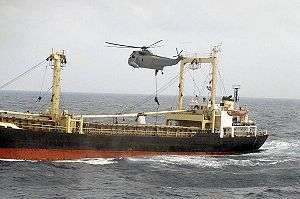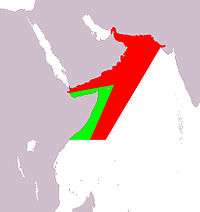Combined Task Force 150

Combined Task Force 150 (CTF-150) is a multinational coalition naval task force working under the 25-nation coalition of Combined Maritime Forces and is based in Bahrain established to monitor, inspect, board, and stop suspect shipping to pursue the "Global War on Terrorism" and in the Horn of Africa region (HOA) (includes operations in the North Arabia Sea to support operations in the Indian Ocean. These activities are referred to as Maritime Security Operations (MSO).
Countries presently contributing to CTF-150 include Pakistan, Canada, Denmark,[1] France, Japan, Germany, the United Kingdom and the United States. Other nations who have participated include Australia, Italy, India, Malaysia, Netherlands, New Zealand, Portugal, Singapore, Spain, Thailand and Turkey. The command of the task force rotates among the different participating navies, with commands usually lasting between four and six months. The task force usually comprises 14 or 15 ships.[2] CTF-150 is coordinated by the Combined Maritime Forces (CMF), a 25-nation coalition operating from the US Navy base in Manama, Bahrain.
2002–2005
Before 11 September 2001, Task Force 150 was a U.S. Navy formation serving as part of U.S. Naval Forces Central Command. After 11 September, it became a patrol force in the Horn of Africa region. On 5 May 2002, command of the force was handed over from the United States to Germany.[3] The German Defence Ministry announced in Berlin that day that the leadership of the Task Force, supported by five nations, was to be handed over from Captain Frothingham (U.S. Navy) to German Admiral Gottfried Hoch.
On 9 December 2002, the SPS Navarra intercepted and boarded the freighter So San, several hundred miles southeast of Yemen at the request of the U.S. government as part of Operation Enduring Freedom. The So San, sailing without a flag, attempted evasive action, so the Navarra after firing four warning shots into the water at the bow of the ship and rifle fire on the ship's hull, getting no answer, fired on a cable crossing the So San from bow to stern to remove obstacles and proceeded to approach it from a helicopter. The ship from North Korea was carrying a cargo of 15 Scud missiles, 15 conventional warheads with 250 kg of high explosive, 23 fuel tanks of nitric acid and 85 drums of chemicals. Yemen subsequently reported that the cargo belonged to them and protested against interception, ordering the United States returned.

On 20 December 2002, a meeting was held aboard the USS Mount Whitney with military leaders from Djibouti regarding the Combined Joint Task Force - Horn of Africa. At the time, CTF-150 was commanded by Spanish Rear Admiral Juan Moreno, and comprised ships from France, Spain, Germany, the United Kingdom and United States.[4]
In January 2003, the task force held a visit, board, search and seizure (VBSS) exercise[5] involving the following vessels:
- Spain: SPS Navarra (flagship, frigate)
- United States: USS Mount Whitney – (command ship)
- Germany: Mecklenburg-Vorpommern (F218) (frigate), Rhön (A1443) (tanker)
- Japan: JMSDF Samidare (DD-106) (destroyer), JDS Myōkō (DDG-175) (AEGIS destroyer), JDS Towada (AOE-422) (replenishment oiler)

On 8 June 2005, CTF-150, under the command of Royal Navy Commodore Tony Rix, successfully conducted the boarding of the vessel Safari in international waters, leading to the seizure of 2.3 tons of hashish. The French D'Estienne d'Orves-class frigate Commandant Birot (F796) performed the boarding. The captured crew were transferred to the Arleigh Burke-class destroyer USS O'Kane (DDG 77).[6]
On 17 August 2005, French Vice Admiral Jacques Mazars replaced British Royal Navy Commodore Tony Rix as commander of CTF-150. At the time, it comprised ships of Italy, France, Germany, Pakistan, Canada, the United Kingdom and United States.[7]
2006–2008: Operations off Somalia
Anti-piracy operations

The CTF-150 has been engaged in anti-piracy operations in Somalia in parallel to other independent anti-piracy operations by countries such as China, Iran, India and Russia.
On 22 January 2006 USS Winston S. Churchill captured a suspected pirate vessel in the Indian Ocean as part of an ongoing effort to help maintain law and order in the region.[8]
In the action of 18 March 2006, two United States Navy ships were attacked by Somali pirates during an opposed boarding. In the ensuing gun battle, all the pirates were either killed or captured.
On 4 April 2006, the South Korean fishing vessel MV Dong Won (628) reported it had come under rocket attack off the coast of Somalia. Immediately two ships from the task force, the Dutch frigate HNLMS De Zeven Provinciën (F802) and the U.S. guided-missile destroyer USS Roosevelt (DDG-80) responded. However, the pirates had already hijacked the vessel and reached Somali territorial waters after threatening the captured crew members.[9]
On 22 August 2006, Rear Adm. Iqbal was relieved by German Rear Admiral Heinrich Lange.[10]
In December 2006, Lange passed control to British Royal Navy Commodore Bruce Williams.
In March 2007, the Dutch frigate Hr.Ms. Evertsen deployed to the waters of the Horn of Africa, as part of CTF-150, and in response to a request from the United Nations World Food Programme, against piracy off the Somalian coast.
The CTF-150 established the Maritime Security Patrol Area on 22 August 2008, through a narrow corridor within the Gulf of Aden aimed at deterring attack and hijacking of ships seeking safe passage through the zone.[11]
Also in August 2008, the Danish command & support ship HDMS Absalon deployed to join and lead CTF 150 for a 6-month tour. On 17 September 2008, the Danish ship captured 10 pirates in two small ships. The pirates were in possession of ladders and other implements with which to board ships, as well as rocket launchers, machine pistols, and grenades. After consulting with the Danish Ministry of Justice and other task force members, it was determined by the Danish Ministry of Foreign Affairs that the pirates could only be prosecuted in Denmark, partly because the pirates would have faced the death penalty in the nearby states, and Danish law prohibits extraditing criminals when they might face the death penalty. Eventually, the pirates were freed, since the Danish authorities were concerned that it would be difficult to deport them back to Somalia once their sentences were served. The pirates were allowed to keep their ships, though not their weapons.[12][13]
In December, 2008, Absalon was involved in the rescue of putative Somali pirates 90 miles off Yemen in the Gulf of Aden. The craft from Somalia was reported to hold rocket-propelled grenades and AK-47 assault rifles, and to have been adrift for several days. Also per the report, the Absalon took the sailors and weapons aboard, sank the craft, and turned the sailors over to the Yemen coast guard. The Absalon, according to The New York Times report, "was deployed in the Gulf of Aden [in] September ['08] as part of an international effort to curb piracy."[14] part of Combined Task Force 150.
Interdiction
Throughout 2006, the Somali Civil War continued to escalate. During this time, the task force conducted normal operations in the Indian Ocean. By early 2007 it became actively involved in providing a maritime cordon to prevent the escape of members of Al Qaeda suspected of being embedded within the ranks of the Islamic Courts Union (ICU).
Open warfare broke out between Ethiopian and the ICU forces on 20 December 2006, but until 2 January 2007 there had been no request by the Ethiopian or Somali military for CTF-150 to take action.[15] On that day, the aim of the patrols shifted to "...stop SICC leaders or foreign militant supporters escaping".[16]
On 4 January 2008 ships of the task force began performing Visit, Board, Search, and Seizure (VBSS) missions, boarding fishing boats (dhows) and oil tankers passing near the Somali coast.[17] US ships of Combined Task Force 150 include the Arleigh Burke-class destroyer USS Ramage and the Ticonderoga-class cruiser USS Bunker Hill.[18] Commodore Bruce Williams of the Royal Navy led the task force at this time.[19]
See also
References
- ↑ "Dansk flåde sat ind mod pirater - International" (in Danish). Jp.dk. 2008-08-20. Retrieved 2014-06-27.
- ↑ "Pakistani Admiral Takes Command of Regional Maritime Task Force". United States Navy. 24 April 2006. Archived from the original on 9 January 2007. Retrieved 11 January 2007.
- ↑ ddp news agency, Berlin - 5 May 2002 via nl.newsbank.com
- ↑ "Horn of Africa Group Meets with Regional Leaders". American Forces Press Service. 30 December 2002. Archived from the original on 30 December 2006. Retrieved 11 January 2007.
- ↑ "Forces Combine to Train at Sea". American Forces Press Service. 6 January 2003. Archived from the original on 10 January 2007. Retrieved 11 January 2007.
- ↑ "Coalition Warships Intercept Drug Smugglers". 8 June 2005. Archived from the original on 3 July 2007. Retrieved 11 January 2007.
- ↑ "French Take Helm of Combined Task Force 150". 24 August 2005. Retrieved 11 January 2007.
- ↑ "Suspected Pirates Captured Off Somali Coast" (Press release). Headquarters, United States Central Command. 22 January 2006. Retrieved 15 December 2006.
- ↑ "Coalition Naval Assets Challenge Hijackers On South Korean Motor Vessel". United States Navy. 4 April 2006. Retrieved 11 January 2007.
- ↑ "Pakistan Navy Completes Term as Commander, Task Force 150". United States Navy. 26 August 2006. Retrieved 11 January 2007.
- ↑ "Combined Task Force 150 Thwarts Criminal Activities". cusnc.navy.mil. 22 September 2008. Retrieved 30 November 2008.
- ↑ "Denmark frees ten pirates." Politiken 23 September 2008 (Danish)
- ↑ "Somali pirates can end up in Denmark." Politiken 22 September 2008 (Danish)
- ↑ Danish Navy Rescues Suspected Pirates by Alan Cowell, The New York Times 12-6-08
- ↑ "No request yet from Somali leaders for help in interdicting militants, 5th Fleet says". Stars & Stripes. 2 January 2007. Retrieved 11 January 2007.
- ↑ "Ethiopian troops to stay in Somalia weeks". Reuters. 2 January 2007.
- ↑ "U.S. ships hunt for al Qaeda off Somalia". London Daily Telegraph. 4 January 2007. Retrieved 11 January 2007.
- ↑ "Ramage, Bunker Hill keeping an eye on Somalia". MarineTimes.com. 4 January 2007. Retrieved 4 January 2007.
- ↑ "Combined Task Force 150 Maintains Presence Off East Coast of Africa". United States Navy. 5 January 2007. Retrieved 11 January 2007.
External links
| Wikimedia Commons has media related to Combined Task Force 150. |